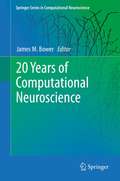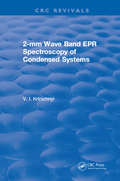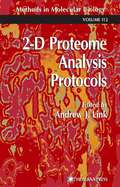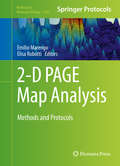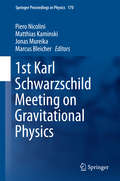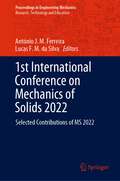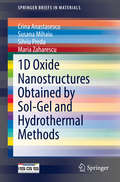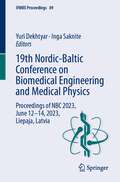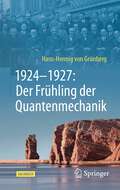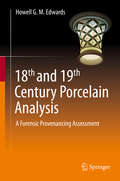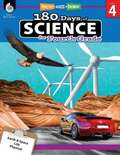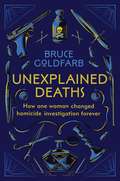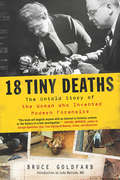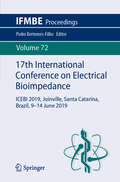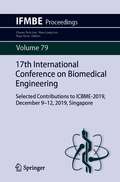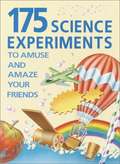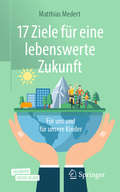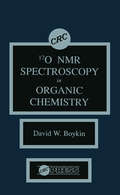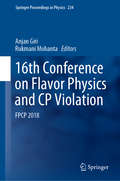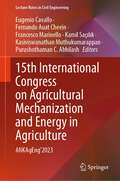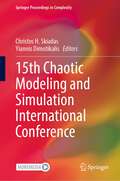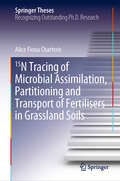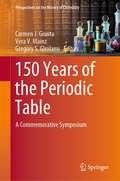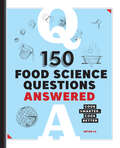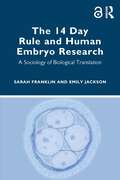- Table View
- List View
20 Years of Computational Neuroscience (Springer Series in Computational Neuroscience #9)
by James M BowerWhen funding agencies and policy organizations consider the role of modeling and simulation in modern biology, the question is often posed, what has been accomplished ? This book will be organized around a symposium on the 20 year history of the CNS meetings, to be held as part of CNS 2010 in San Antonio Texas in July 2010. The book, like the symposium is intended to summarize progress made in Computational Neuroscience over the last 20 years while also considering current challenges in the field. As described in the table of contents, the chapter's authors have been selected to provide wide coverage of the applications of computational techniques to a broad range of questions and model systems in neuroscience. The proposed book will include several features that establish the history of the field. For each article, its author will select an article originally appearing in a CNS conference proceedings from 15 - 20 years ago. These short (less than 6 page) articles will provide illustrations of the state of the field 20 years ago. The new articles will describe what has been learned about the subject in the following 20 years, and pose specific challenges for the next 20 years. The second historical mechanism will be the reproduction of the first 12 years of posters from the CNS meeting. These posters in and of themselves have become famous in the field (they hang in the halls of the NIH in Bethesda Maryland) and were constructed as allegories for the state and development of computational neuroscience. The posters were designed by the book's editor, who will, for the first time, provide a written description of each poster.
2-mm Wave Band EPR Spectroscopy of Condensed Systems
by V. I. KrinichnyiThis is the first book to summarize the problems of using modern high-resolution 2-mm wave band EPR spectroscopy in an interdisciplinary field for the investigation of various condensed systems. The material is well illustrated and the applications are as diverse as possible. The main subjects included are: unique characteristics of 2-mm EPR spectroscopy and appropriate experimental techniques, dynamics and polarity of radical microenvironment in model and biological systems, and the nature of charge carriers and charge transfer mechanisms in organic polymer semiconductors.
2-D Proteome Analysis Protocols (Methods in Molecular Biology #112)
by Andrew J. LinkA step-by-step tour through the complete process of doing proteomics. With easy-to-follow instructions, complete with many helpful hints and explanations, leading investigators and pioneers in the field show how to make protein extracts, reproducibly run them on 2-D gels, detect them, analyze the data, and precisely identify each protein. The book covers the latest methods of using carrier ampholytes in the 1st dimension, casting and running immobilized pH gradient 2-D gels, MALDI-TOF-based peptide mapping, automated tandem mass spectrometry, and nanoelectrospray ionization technology. For the 2nd dimension, there are methods for running flatbed or vertical gels and for protein detection using autoradiography, and Coomassie, silver, and reversible metal-chelate stains. 2-D Proteome Analysis Protocols is the most complete guide for using proteomics to answer biological questions.
2-D PAGE Map Analysis: Methods and Protocols (Methods in Molecular Biology #1384)
by Emilio Marengo Elisa RobottiExploring the 2-D gel mapping field, the chapters in this book are separated into four different categories: Part I talks about 2-D maps reproducibility and maps modeling; Part II describes the image analysis tools that provide spot volume datasets; Part III is about the statistical methods applied to spot volume datasets to identify candidate biomarkers; and Part IV discusses differential analysis from direct image analysis tools. 2-D PAGE Map Analysis: Methods and Protocols provides a unique approach to 2-D gel mapping, in that it helps users avoid drawbacks due to ignorance of the basic theoretical mechanisms underlying the technique, including data handling and proper tools for spot analysis. Written in the highly successful Methods in Molecular Biology series format, chapters include introductions to their respective topics, lists of the necessary materials, step-by-step, readily reproducible laboratory protocols, and tips on troubleshooting and avoiding known pitfalls. Cutting-edge and thorough, 2-D PAGE Map Analysis: Methods and Protocols, is a useful resource for any scientist or researcher, with a mathematical background, who is interested in 2-D gel mapping.
1st Karl Schwarzschild Meeting on Gravitational Physics (Springer Proceedings in Physics #170)
by Piero Nicolini Matthias Kaminski Jonas Mureika Marcus BleicherThese proceedings collect the selected contributions of participants of the First Karl Schwarzschild Meeting on Gravitational Physics, held in Frankfurt, Germany to celebrate the 140th anniversary of Schwarzschild's birth. They are grouped into 4 main themes: I. The Life and Work of Karl Schwarzschild; II. Black Holes in Classical General Relativity, Numerical Relativity, Astrophysics, Cosmology, and Alternative Theories of Gravity; III. Black Holes in Quantum Gravity and String Theory; IV. Other Topics in Contemporary Gravitation. Inspired by the foundational principle ``By acknowledging the past, we open a route to the future", the week-long meeting, envisioned as a forum for exchange between scientists from all locations and levels of education, drew participants from 15 countries across 4 continents. In addition to plenary talks from leading researchers, a special focus on young talent was provided, a feature underlined by the Springer Prize for the best student and junior presentations.
1st International Conference on Mechanics of Solids 2022: Selected Contributions of MS 2022 (Proceedings in Engineering Mechanics)
by António J. M. Ferreira Lucas F. M. da SilvaThis book provides selected papers presented at the 1st International Conference on Mechanics of Solids, held in Porto, Portugal, November 3-4, 2022.The book focuses on the mechanics of deformable solids, dynamics of particles and rigid bodies. Topics like mechanical behaviour of materials, mechanics of composite materials, plasticity, fracture mechanics, and optimum design methods are covered. This volume provides the latest trends related to mechanics of solids and appeals to researchers and practitioners across the broad spectrum.
1D Oxide Nanostructures Obtained by Sol-Gel and Hydrothermal Methods (SpringerBriefs in Materials)
by Crina Anastasescu Susana Mihaiu Silviu Preda Maria ZaharescuThis book presents wet chemical sol-gel and hydrothermal methods for 1D oxide nanostructure preparation. These methods represent an attractive route to multifunctional nanomaterials synthesis, as they are versatile, inexpensive and, thus, appropriate for obtaining a wide range of oxide materials with tailored morphology and properties. Three specific oxides (SiO2, TiO2, ZnO) are discussed in detail in order to illustrate the principle of the sol-gel and hydrothermal preparation of 1D oxide nanostructures. Other oxides synthesized via this method are also briefly presented. Throughout the book, the correlation between the tubular structure and the physico-chemical properties of these materials is highlighted. 1D oxide nanostructures exhibit interesting optical and electrical properties, due to their confined morphology. In addition, a well-defined geometry can be associated with chemically active species. For example, the pure SiO2 nanotubes presented a slight photocatalytic activity, while the Pt-doped SiO2 tubular materials act as microreactors in catalytic reactions. In the case of titania and titanate nanotubes, large specific surface area and pore volume, ion-exchange ability, enhanced light absorption, and fast electron-transport capability have attracted significant research interest. The chemical and physical modifications (microwave assisted hydrothermal methods) discussed here improve the formation kinetics of the nanotubes. The ZnO nanorods/tubes were prepared as random particles or as large areas of small, oriented 1D ZnO nanostructures on a variety of substrates. In the latter case a sol-gel layer is deposited on the substrate prior to the hydrothermal preparation. Using appropriate dopants, coatings of ZnO nanorods with controlled electrical behavior can be obtained.
19th Nordic-Baltic Conference on Biomedical Engineering and Medical Physics: Proceedings of NBC 2023, June 12–14, 2023, Liepaja, Latvia (IFMBE Proceedings #89)
by Yuri Dekhtyar Inga SakniteThis book reports on new trends, challenges and solutions, in the multidisciplinary fields of biomedical engineering and medical physics. Contributions spans from biomechanics, to robotic rehabilitation, radiation oncology, and image and signal processing, among many other topics. They cover advanced devices for diagnosis or patient monitoring, as well as for therapy (non-invasive surgery, rehabilitation and more). Gathering the proceedings of the 19th Nordic-Baltic Conference on Biomedical Engineering and Medical Physics, NBC 2023, held on June 12–14, 2023, in Liepaja, Latvia, this book is expected to inform a wide audience of researchers, engineers and other professionals working in the broad field of biomedical engineering, and to offer a timely snapshot of research and projects that have been carried out within Nordic and Baltic countries, in particular, but not limited to them.
1924–1927: Der Frühling der Quantenmechanik
by Hans-Hennig von GrünbergSeines Heuschnupfens wegen verbrachte Werner Heisenberg im Juni 1925, vor nun bald hundert Jahren, zehn Tage auf der Insel Helgoland, wo er einen Artikel schrieb, der als der Beginn der Geschichte der modernen Quantentheorie angesehen werden kann. Im Oktober 1927 fand die fünfte Solvay-Konferenz in Brüssel statt, die wohl berühmteste Konferenz in der Geschichte der Physik, und brachte die spannende Entstehungsgeschichte der Quantenmechanik zu ihrem vorläufigen Ende. In diesen Jahren zwischen 1925 und 1927 entwickelten acht Physiker aus fünf Ländern eine Theorie, die das physikalische Verständnis unserer Welt radikal verändert sollte. Mit diesem Buch wandert man vom September 1924 bis zum Oktober 1927 durch die Zeit und erfährt dabei in Form von Monatsberichten, wie die Quantenmechanik entstanden ist, was die handelnden Personen erlebt und gedacht, in welcher Zeit sie gelebt haben und wie aus dem Zusammenspiel Einzelner langsam das gemeinsame Ganze entstanden ist. Das Buch wendet sich an Laien, die sich von der Quantenmechanik faszinieren lassen wollen und dabei verstehen werden, dass diese Theorie wie Anita Berber, der Jazz oder die Erfindung des Fernsehens ein typisches Kind der 1920er Jahre ist.
18th and 19th Century Porcelain Analysis: A Forensic Provenancing Assessment
by Howell G. EdwardsThis book addresses the contributions made by analytical chemistry to the characterisation of 18th and early 19th Century English and Welsh porcelains commencing with the earliest reports of Sir Arthur Church and of Herbert Eccles and Bernard Rackham using chemical digestion techniques and concluding with the most recent instrumental experiments, which together span more than a hundred years of study. From the earliest experiments which required necessarily the sacrifice of significant portions of each specimen, which may already have been damaged , to the latest experiments which needed only microsampling or the non-destructive interrogation of valuable perfect specimens a comprehensive survey is undertaken of more than twenty manufactories of quality porcelains. The correlation is made between the quantitative elemental oxide determinations of the scanning electron microscopic diffraction and Xray fluorescence data and the qualitative molecular spectroscopic Raman data to demonstrate their complementarity and use in the holistic forensic assessment of the origin of the fired procelains ; this will form the groundwork for the adoption of analytical techniques for the attribution of unknown or questionable procelains to their potential source factories . The book will also examine the perception of what constitutes a porcelain and its definitions and examines the assignment of porcelains to types which currently employs the definitions of hard paste , soft paste , hybrid , magnesian and bone china from the conclusions derived from the analytical data and a consideration of the raw materials employed in their manufacturing processes. During the discussion of this analytical evidence several themes and protocols have been established for its utilisation in the potential identification of porcelains and several case studies undertaken for this purpose are cited. The book will be of interest to analytical scientists , to museum ceramics curators and to ceramics historians.
180 Days of Science for Fourth Grade: Practice, Assess, Diagnose
by Lauren Homayoun180 Days of Science is a fun and effective daily practice workbook designed to help students explore the three strands of science: life, physical, and earth and space. <P><P>This easy-to-use fourth grade workbook is great for at-home learning or in the classroom. The engaging standards-based activities cover grade-level skills with easy to follow instructions and an answer key to quickly assess student understanding. Students will explore a new topic each week building content knowledge, analyzing data, developing questions, planning solutions, and communicating results. Watch as students are motivated to learn scientific practices with these quick independent learning activities. Parents appreciate the teacher-approved activity books that keep their child engaged and learning. Great for homeschooling, to reinforce learning at school, or prevent learning loss over summer. <P><P>Teachers rely on the daily practice workbooks to save them valuable time. The ready to implement activities are perfect for daily morning review or homework. The activities can also be used for intervention skill building to address learning gaps. Aligns to Next Generation Science Standards (NGSS).
18 Tiny Deaths: The Untold Story of Frances Glessner Lee and the Invention of Modern Forensics
by Bruce GoldfarbFor most of human history, sudden and unexpected deaths of a suspicious nature, when they were investigated at all, were examined by lay persons without any formal training. People often got away with murder. Modern forensic investigation originates with Frances Glessner Lee - a pivotal figure in police science.'Disturbing dioramas created by an American millionairess revolutionised the art of modern forensics.' DAILY TELEGRAPH Frances Glessner Lee (1878-1962), born a socialite to a wealthy and influential Chicago family, was never meant to have a career, let alone one steeped in death and depravity. Yet she became the mother of modern forensics and was instrumental in elevating homicide investigation to a scientific discipline. Frances Glessner Lee learned forensic science under the tutelage of pioneering medical examiner Magrath - he told her about his cases, gave her access to the autopsy room to observe post-mortems and taught her about poisons and patterns of injury. A voracious reader too, Lee acquired and read books on criminology and forensic science - eventually establishing the largest library of legal medicine. Lee went on to create The Nutshell Studies of Unexplained Death - a series of dollhouse-sized crime scene dioramas depicting the facts of actual cases in exquisitely detailed miniature - and perhaps the thing she is most famous for. Celebrated by artists, miniaturists and scientists, the Nutshell Studies are a singularly unusual collection. They were first used as a teaching tool in homicide seminars at Harvard Medical School in the 1930s, and then in 1945 the homicide seminar for police detectives that is the longest-running and still the highest-regarded training of its kind in America. Both of which were established by the pioneering Lee.In 18 Tiny Deaths, Bruce Goldfarb weaves Lee's remarkable story with the advances in forensics made in her lifetime to tell the tale of the birth of modern forensics.
18 Tiny Deaths: The Untold Story of Frances Glessner Lee and the Invention of Modern Forensics
by Bruce Goldfarb"Eye-opening biography of Frances Glessner Lee, who brought American medical forensics into the scientific age...genuinely compelling."—Kirkus Reviews "A captivating portrait of a feminist hero and forensic pioneer." —BooklistThe story of a woman whose ambition and accomplishments far exceeded the expectations of her time, 18 Tiny Deaths follows the transformation of a young, wealthy socialite into the mother of modern forensics...Frances Glessner Lee, born a socialite to a wealthy and influential Chicago family in the 1870s, was never meant to have a career, let alone one steeped in death and depravity. Yet she developed a fascination with the investigation of violent crimes, and made it her life's work. Best known for creating the Nutshell Studies of Unexplained Death, a series of dollhouses that appear charming—until you notice the macabre little details: an overturned chair, or a blood-spattered comforter. And then, of course, there are the bodies—splayed out on the floor, draped over chairs—clothed in garments that Lee lovingly knit with sewing pins.18 Tiny Deaths, by official biographer Bruce Goldfarb, delves into Lee's journey from grandmother without a college degree to leading the scientific investigation of unexpected death out of the dark confines of centuries-old techniques and into the light of the modern day.Lee developed a system that used the Nutshells dioramas to train law enforcement officers to investigate violent crimes, and her methods are still used today.18 Tiny Deaths transports the reader back in time and tells the story of how one woman, who should never have even been allowed into the classrooms she ended up teaching in, changed the face of science forever.
17th International Conference on Electrical Bioimpedance: ICEBI 2019, Joinville, Santa Catarina, Brazil, 9-14 June 2019 (IFMBE Proceedings #72)
by Pedro Bertemes-FilhoThis book gathers the proceedings of the 17th International Conference on Electrical Bioimpedance (ICEBI 2019), held on June 9-14, in Joinville, Santa Catarina, Brazil. The chapters cover the latest knowledge and developments concerning: sensors and instrumentation to measure bioimpendance, bioimpedance imaging techniques, theory and modeling and bioimpendance, as well as cutting-edge clinical applications of bioimpendance. All in all, this book provides graduate students and researchers with an extensive and timely snapshot of current research and challenges in the field of electrical bioimpendance, and a source of inspiration for future research and cross-disciplinary collaborations.
17th International Conference on Biomedical Engineering: Selected Contributions to ICBME-2019, December 9–12, 2019, Singapore (IFMBE Proceedings #79)
by Chwee Teck Lim Hwa Liang Leo Raye YeowThis book gathers contributions presented at the 17th International Conference on Biomedical Engineering, held on December 9-12, 2019, in Singapore. It continues the tradition of the previous conference proceedings, thus reporting on both fundamental and applied research. It includes a set of carefully selected chapters reporting on new models and algorithms and their applications in medical diagnosis or therapy. It also discusses advances in tele-health and assistive technologies, as well as applications of nanotechnologies. Organized jointly by the Department of Biomedical Engineering of the National University of Singapore and the Biomedical Engineering Society (Singapore), this book offers a timely snapshot of innovative research and technologies and a source of inspiration for future developments and collaborations in the field of biomedical engineering.
175 Science Experiments to Amuse and Amaze Your Friends: Experiments, Tricks, Things to Make
by Brenda Walpole"Facts, experiments, tricks based on scientific principles, and things to make comprise the text of this book. The material is divided into four sections--water, air, movement, and light. The language used is clear, concise, and interesting. Every experiment, trick, and object to make is not only explained clearly but illustrated as well, making the book especially useful for the visual learner. There is so much here to intrigue readers! This will surely bring young readers into the interesting world of science." --(starred)Science Books & Films.
17 Ziele für eine lebenswerte Zukunft: Für uns und für unsere Kinder
by Matthias MedertVielleicht machst auch du dir Sorgen darüber, wohin die vielen ökologischen und sozialen Probleme führen werden, von welcher Art und Ausmaß die Konsequenzen sein können und wie diese das Leben von Menschen betreffen werden? Dann könnte dieses Buch interessant für Dich sein: Es beschreibt anhand der 17 UN-Nachhaltigkeitsziele eine Vision für eine lebenswerte Zukunft. Du erfährst kurz und verständlich zu jedem der Ziele konkrete Hintergründe, Zusammenhänge und Herausforderungen, die es auf dem Weg dorthin noch zu meistern gilt. Es macht die Themen greifbar - sowohl global als auch bezogen auf Deutschland. Gleichzeitig liefert Dir das Buch Anregungen, wie Du selbst dazu beitragen kannst, die großen Probleme der Menschheit zu lösen: Klimawandel, Energie, Plastikmüll, Artenvielfalt, Umweltschutz, Hunger, Armut, etc.Zusammen können wir es schaffen, die 17 Ziele umzusetzen, indem wir sie mit konkreten Inhalten füllen. Falls uns das gelingt fragen unsere Kinder vielleicht eines Tages: „Wie habt ihr damals die Erde gerettet und die Menschheit in das Zeitalter der sozialen Gerechtigkeit geführt?“
17 0 NMR Spectroscopy in Organic Chemistry
by David W. BoykinThis book provides a comprehensive review of the application of 17O NMR spectroscopy to organic chemistry. Topics include the theoretical aspects of chemical shift, quadrupolar and J coupling; 17O enrichment; the effect of steric interactions on 17O chemical shifts of functional groups in flexible and rigid systems; the application of 17O NMR spectroscopy to hydrogen bonding investigations; mechanistic problems in organic and bioorganic chemistry; and 17O NMR spectroscopy of oxygen monocoordinated to carbon in alcohols, ethers, and derivatives. Recent results that show correlations between molecular geometry, determined by X-ray studies and estimated by molecular mechanics calculations, and 17O chemical shifts are also covered. 17O Spectroscopy in Organic Chemistry provides important reference information for organic chemists and other scientists interested in 17O NMR spectroscopy as a tool for obtaining new structural and chemical data about organic molecules.
16th Conference on Flavor Physics and CP Violation: FPCP 2018 (Springer Proceedings in Physics #234)
by Anjan Giri Rukmani MohantaPresenting the proceedings of FPCP 2018, this book reviews the status quo of flavor physics and discusses the latest findings in this exciting area. Flavor physics has been instrumental in the formulation and understanding of the standard model, and it is possible that the direction of new physics will be significantly influenced by flavor sector, also known as the intensity frontier, making it possible to indirectly test the existence of new physics up to a very high scale, beyond that of the energy frontier scale accessible at the LHC.The book is intended for academics around the globe involved in particle physics research, professionals associated with the related technologies and those who are interested in learning about the future of physics and its prospects and directions.
15th International Congress on Agricultural Mechanization and Energy in Agriculture: ANKAgEng’2023 (Lecture Notes in Civil Engineering #458)
by Eugenio Cavallo Fernando Auat Cheein Francesco Marinello Kamil Saçılık Kasiviswanathan Muthukumarappan Purushothaman C. AbhilashThis volume highlights the latest advances, innovations, and applications in the field of agricultural technologies engineering, as presented by leading international researchers and engineers at the 15th International Congress on Agricultural Mechanization and Energy in Agriculture (ANKAgEng), held in Antalya, Turkey on October 29 – November 1, 2022. It covers a diverse range of topics such as machinery and energy systems, agriculture information technologies, digital-smart agriculture, ergonomics, health & safety, system engineering, post-harvest technologies & process engineering, sustainable agriculture, natural resources & environmental systems, plant, animal & facility systems, agricultural engineering education and biosystems engineering. The contributions, which were selected by means of a rigorous international peer-review process, present a wealth of exciting ideas that will open novel research directions and foster multidisciplinary collaboration among different specialists.
15th Chaotic Modeling and Simulation International Conference (Springer Proceedings in Complexity)
by Christos H. Skiadas Yiannis DimotikalisThis proceedings of 15th CHAOS2022 International Conference highlights recent developments in nonlinear, dynamical, and complex systems. The conference was intended to provide an essential forum for Scientists and Engineers to exchange ideas, methods, and techniques in the field of Nonlinear Dynamics, Chaos, Fractals and their applications in General Science and Engineering Sciences. The principal aim of CHAOS2022 International Conference is to expand the development of the theories of the applied nonlinear field, the methods, empirical data and computer techniques as well as the best theoretical achievements of chaotic theory. CHAOS2022 Conference provides a forum for bringing together the various groups working in the area of Nonlinear and Dynamical Systems, Chaotic theory and Application to exchange views and report research findings.
15N Tracing of Microbial Assimilation, Partitioning and Transport of Fertilisers in Grassland Soils (Springer Theses)
by Alice Fiona CharterisThis book presents innovative research on soil nitrogen cycling and nitrate leaching with a view to improving soil management and fertiliser nitrogen use efficiency and reducing nitrogen leaching losses. In this regard, nitrogen-15 (15N)-labelled fertiliser was used as a biochemical and physical stable isotope tracer in laboratory and field experiments. The major outcome of the research was the development, validation and application of a new compound-specific amino acid 15N stable isotope probing method for assessing the assimilation of fertiliser nitrogen by soil microbial biomass. The novelty of the method lies in its tracing of incorporated nitrogen into newly biosynthesised microbial protein in time-course experiments using gas chromatography-combustion-isotope ratio mass spectrometry. The approach provides previously unattainable insights into the microbial processing of different nitrogen fertilisers in different soils. Further, it identifies the mechanistic link between molecular-scale processes and observations of field-scale fertiliser nitrogen immobilisation studies. The method and the results presented here will have far-reaching implications for the development of enhanced recommendations concerning farm-based soil management practices for increasing soil productivity and reducing nitrogen losses, which is essential to minimising environmental impacts.
150 Years of the Periodic Table: A Commemorative Symposium (Perspectives on the History of Chemistry)
by Carmen J. Giunta Vera V. Mainz Gregory S. GirolamiThis book provides an overview of the origins and evolution of the periodic system from its prehistory to the latest synthetic elements and possible future additions. The periodic system of the elements first emerged as a comprehensive classificatory and predictive tool for chemistry during the 1860s. Its subsequent embodiment in various versions has made it one of the most recognizable icons of science. Based primarily on a symposium titled “150 Years of the Periodic Table” and held at the August 2019 national meeting of the American Chemical Society, this book describes the origins of the periodic law, developments that led to its acceptance, chemical families that the system struggled to accommodate, extension of the periodic system to include synthetic elements, and various cultural aspects of the system that were celebrated during the International Year of the Periodic Table.
150 Food Science Questions Answered: Cook Smarter, Cook Better
by Bryan LeCooking isn't just an art, it's a science—150 fascinating food facts to make you a better cook Does cold water come to a boil faster than warm water? Why does fat taste so good? What makes popcorn pop? Most of the processes that occur during cooking are based on principles found in biology, chemistry, and physics. 150 Food Science Questions Answered is an intriguing look into the science of food, from the eyes of a food science Ph.D. candidate and recipient of the James Beard Legacy Scholarship. Learn food science—how controlling heat, moisture, acidity, and salt content can magically transform the way flavors are developed and perceived. Understand the food science behind the few hundred milliseconds that creates our sense of taste. With increased knowledge will come increased mastery, no matter what you're cooking. Inside 150 Food Science Questions Answered you'll find: Can you control garlic's intensity by the way you cut it?—Garlic's signature burn is released when its cell walls are cut into. Whole garlic will impart mild flavor; garlic crushed into a paste will deliver the strongest punch. Does alcohol burn off when cooked?—Quick processes like flambé eliminate only about 25% of alcohol, while long-simmering can remove almost all of it. Does searing a steak seal in the juices?—No, but it does develop delicious flavors through a process called the Maillard reaction. Learn food science and you'll be on your way to truly understanding the chemistry of cooking.
The 14 Day Rule and Human Embryo Research: A Sociology of Biological Translation
by Sarah Franklin Emily JacksonThis assessment of Britain’s influential 14 day rule governing embryo research explores how and why it became the de facto global standard for research into human fertilisation and embryology, arguing that its influence and stability offers valuable lessons for successful biological translation.One of the most important features of the 14 day rule, the authors claim, is its reliance on sociological as well as ethical, legislative, regulatory and scientific principles. The careful integration of social expectations and perceptions, as well as sociological definitions of the law and morality, into the development of a robust legislative infrastructure of ‘human fertilisation and embryology’, enabled what has come to be known as the Warnock Consensus – a solid and enduring public acceptance that has enabled successive parliamentary approval for controversial areas of scientific research in the UK, such as stem cell research and mitochondrial donation, for over 30 years. These important sociological insights are increasingly relevant to new biotranslational challenges such as human germline gene editing and the use of AI assisted technologies in human reproduction. As the legislation around the 14 day rule begins to be reviewed worldwide, the important lessons we can learn from its global and enduring significance will apply not only to future legislation governing embryo research, but to the future of biological translation more widely.An important volume for those interested in reproductive studies, biogovernance and biological translation, it is suitable for researchers, clinicians and students in medicine, biosciences, sociology, and science and technology studies.
